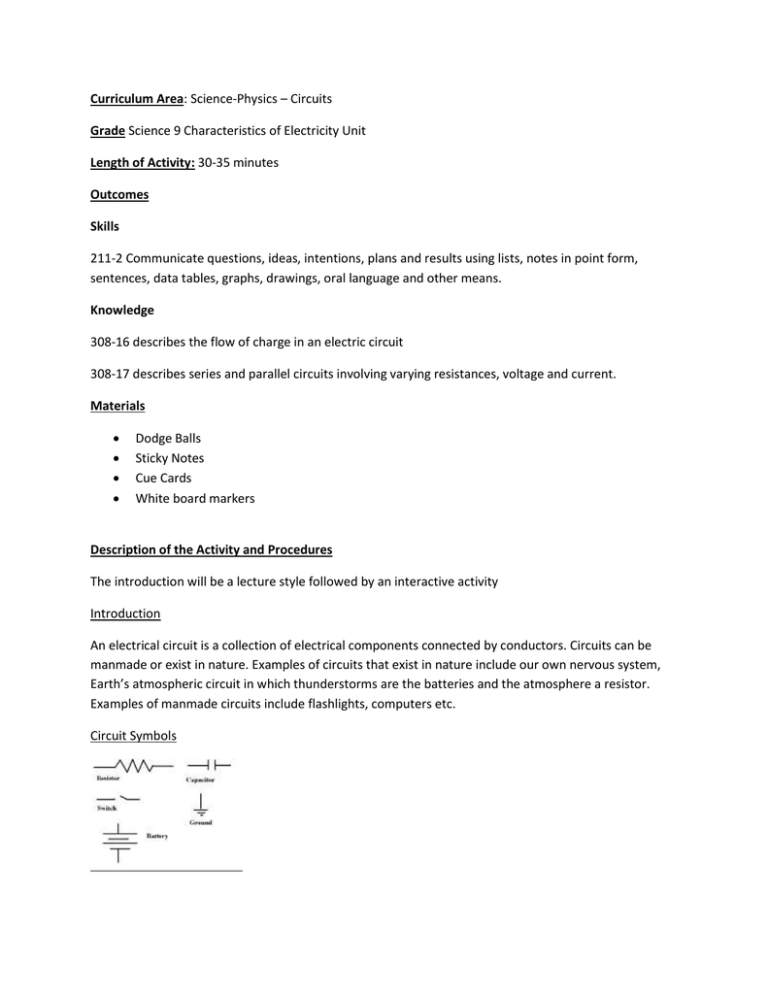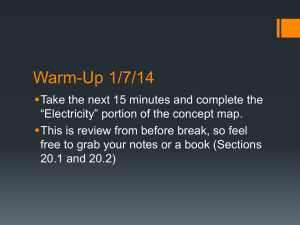
Curriculum Area: Science-Physics – Circuits
Grade Science 9 Characteristics of Electricity Unit
Length of Activity: 30-35 minutes
Outcomes
Skills
211-2 Communicate questions, ideas, intentions, plans and results using lists, notes in point form,
sentences, data tables, graphs, drawings, oral language and other means.
Knowledge
308-16 describes the flow of charge in an electric circuit
308-17 describes series and parallel circuits involving varying resistances, voltage and current.
Materials
Dodge Balls
Sticky Notes
Cue Cards
White board markers
Description of the Activity and Procedures
The introduction will be a lecture style followed by an interactive activity
Introduction
An electrical circuit is a collection of electrical components connected by conductors. Circuits can be
manmade or exist in nature. Examples of circuits that exist in nature include our own nervous system,
Earth’s atmospheric circuit in which thunderstorms are the batteries and the atmosphere a resistor.
Examples of manmade circuits include flashlights, computers etc.
Circuit Symbols
Definitions:
A resistor is a device having resistance to the passage of an electric current. We can think of resistors as
something that eats electric current. Example of resistance is a light bulb.
A switch a device for making and breaking the connection in an electric circuit
The ground is reference point in an electrical circuit from which voltages are measured
Voltage is the electric potential energy per unit of charge.
Current is the flow of electric charge
Talk about the flow of electrons from battery, heat loss and energy from resistors. Using the following
diagrams
The flow of the electrons comes out of the positive end of the battery since electrons flow from positive
field to a negative field. So the flow starts at the + and flows to the -.
Two components are in series if the current flowing through one component has nowhere to go but
through the second component.
Two components are in parallel if they’re connected together at each end, or if the current has a choice
on where to go.
Timeline for lesson
10 minutes
25 minutes
5 minutes
Whole Class Discussion –
Introduction material
Kinulations activity – Building human circuits –
series and parallel.
Have the students complete an exit slip
answering the question, “How are series and
parallel electric circuits different?”
Kinulations Activity
1) Identify students to serve in the following roles:
a) 3 students as batteries (one positive end, one negative end, and one “energy
replenisher”)
b) 4 students as switches (2 ends per switch)
c) 4 students as light bulbs (2 as filaments taking off the charge and 2 as rays of light
indicating brightness)
d) All other students are sections of wire
2) Volleyballs (6-10) represent electric charge (electrons)
3) Each volleyball has 2 sticky taps taped to it that represent energy
4) Once the circuit is complete (no gaps) the battery starts to move charges by accepting them
from the wire at the positive end and passing them along to the negative end. While in the
battery has the charges inside, the energy replenisher adds 2 Energy tags to each charge.
5) When the charges are passed through the wires and switches, they don’t lose any energy.
6) When the charges pass through the bulbs, they lose energy – according to how many bulbs
they have to pass through. The red tags are taken off. Discuss that they are converted into
light and heat.
7) At any time switches can open to break the circuit and stop the flow of charge.
8) A second bulb can be introduced to the series and parallel circuit.
Questions to ask:
1. Where does the energy go in the bulbs?
The energy in light bulbs are released in the two different forms heat and light
2. Why doesn’t the number of charges (electrons) change?
Because they leave the positive side and enter back into the negative, it is a closed loop
3. Why don’t the wires and switches take (use up) energy?
Because they don’t have any resistance.
4. What happens when the second bulb is introduced?
The second light bulb reduces the brightness of the other light bulbs
At the end of the activity have the students complete an exit slip answering the question, “How are
series and parallel electric circuits different?”
Extending to Physics 12
This activity can be extended to physics 12 in the optional unit of electric circuits in the section magnetic
fields. It would be a great activity to explain and derivate Ohm’s law for circuits in series and parallel.
Adoptions for students with exceptionalities
Since there are so many different aspects to what part of the circuit you are going to act out in this
activity, it can be easily modified to suit everyone’s needs. Jobs for students range from being very
involved in the activity (for example being a resister) to having little participation in the activity (for
example being a part of the wire). Being a part of the wire will give students the opportunity to reflect
and analyze what is actually going on in the circuit.
Assessment and Evaluation
Participation is will play a big role in the assessment of this activity. Being able to be different parts of
the circuit in the second half of this class will play a very important role in understanding the abstract
concepts. It will be important for the teacher to set aside some time in order to give a large proportion
of the class the chance to participate as one of the main functions.
Where to go from here and Extending to Physics 12
A natural next step for this lesson would be drawing circuit diagrams from written descriptions and vice
versa as well as questions related to the following formulas
𝑐𝑢𝑟𝑟𝑒𝑛𝑡 =
𝑣𝑜𝑙𝑡𝑎𝑔𝑒
𝑟𝑒𝑠𝑖𝑠𝑡𝑎𝑛𝑐𝑒
𝑎𝑚𝑝𝑒𝑟𝑒𝑠 =
𝑣𝑜𝑙𝑡𝑠
𝑜ℎ𝑚𝑠
Other future activities include relating power consumption to electrical energy and cost.
This activity can be extended to physics 12 in the optional unit of electric circuits in the section magnetic
fields. It would be a great activity to explain and derivate Ohm’s law for circuits in series and parallel.
References
This activity was adopted from the work of Dr Grant Williams Assistant Professor in the Department of
Education at St Thomas University. Dr Williams’s research is focused on Kinulations Activities to teach
abstract concepts to jr and senior high students.
Atlantic Canada Science 9 Curriculum Nova Scotia Department of Education.
Wolfson, R. (2007). Essential university physics . (1 ed., Vol. 1,2, pp. 415-421). San Francisco : Pearson
Addison Wesley






